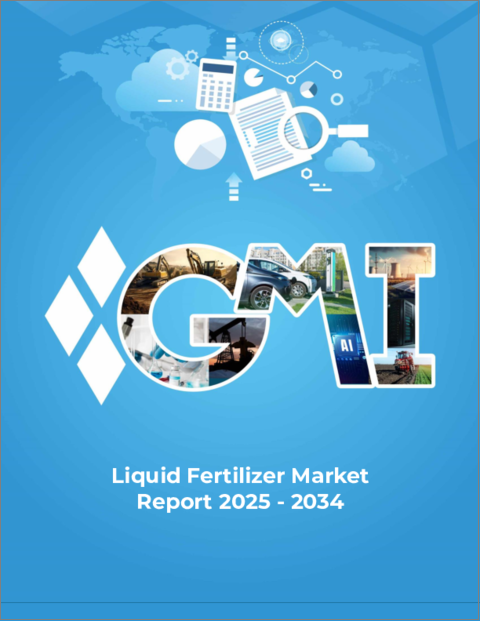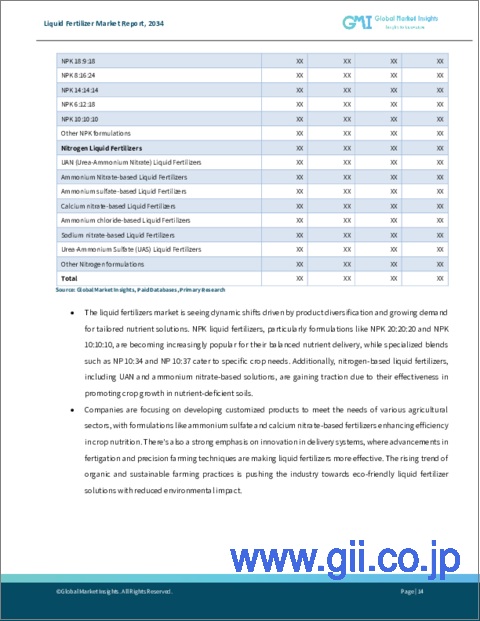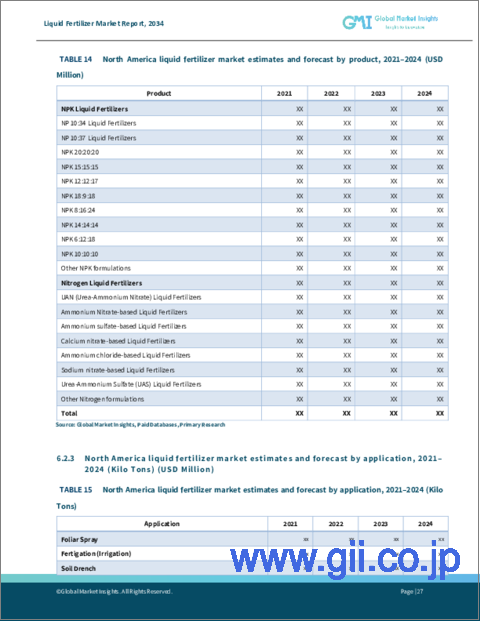|
|
市場調査レポート
商品コード
1576985
液体肥料市場、機会、成長促進要因、産業動向分析と予測、2024年~2032年Liquid Fertilizer Market, Opportunity, Growth Drivers, Industry Trend Analysis and Forecast, 2024-2032 |
||||||
カスタマイズ可能
|
|||||||
| 液体肥料市場、機会、成長促進要因、産業動向分析と予測、2024年~2032年 |
|
出版日: 2024年08月01日
発行: Global Market Insights Inc.
ページ情報: 英文 120 Pages
納期: 2~3営業日
|
- 全表示
- 概要
- 目次
世界の液体肥料市場は2023年に167億米ドルに達し、2024年から2032年にかけてCAGR 5.9%で成長すると予測されています。
この成長の原動力は、効率的な農業投入、迅速な吸収、作物の収量と土壌の健全性を高める液体肥料の優れた栄養供給に対する需要の増加です。技術の進歩と精密農業の採用が、この拡大をさらに後押ししています。市場の成長には、食糧増産を必要とする世界人口の増加も拍車をかけています。農家や農業関連企業は、生産性と持続可能性を向上させるために液体肥料に目を向けています。持続可能な農業を推進する政府の取り組みと農業研究開発への投資は、今後10年間の市場の成長に寄与すると予想されます。
2023年には、NPK液体肥料セグメントは70億米ドルを占め、2032年までにCAGR 6.3%で成長すると予測されています。この成長の原動力となっているのは、多様な土壌条件に対応するバランスの取れた栄養剤の需要です。窒素(N)、カリウム(K)、リン(P)を含むNPK液体肥料は、包括的な栄養サポートを提供し、土壌肥沃度を向上させ、作物の収量を高める。肥料技術と精密農業の進歩は、効果的かつ効率的な養分供給を提供し、このセグメントの拡大に貢献しています。農業の生産性と持続可能性への注目は、NPK液体肥料の採用をさらに後押ししています。
葉面散布アプリケーション分野は、2024年には80億米ドルに達し、2024年から2032年にかけてCAGR 6.0%で成長すると予測されます。この成長の原動力は、葉面散布が植物に直接養分を供給する効果的な方法であるという認識です。葉面散布は、欠乏に迅速に対処し、迅速な養分の取り込みを提供し、作物の健康と生産性を高めることができます。精密農業と散布技術の進歩は、散布効率を改善し、無駄を省く。作物の収量を最適化し、環境への影響を最小限に抑えることが重視されているため、葉面散布の需要が高まっています。
アジア太平洋の液体肥料セクターは、2024年から2032年までのCAGRが6.1%で、75億6,000万米ドルに達すると予測されます。この成長の原動力となっているのは、効率的な養分管理と作物収量を高めるための大規模な農業生産に対するこの地域のニーズです。肥料の配合強化や精密農業といった農業技術の進歩は、養分の供給を改善し、環境への影響を軽減します。アジア太平洋地域では、食糧安全保障に対する懸念の高まりと人口の増加が、最適化された農業投入物に対する需要を促進しています。
目次
第1章 調査手法と調査範囲
第2章 エグゼクティブサマリー
第3章 業界洞察
- エコシステム分析
- 主要メーカー
- 流通業者
- 業界全体の利益率
- 業界への影響要因
- 促進要因
- 市場の課題
- 市場機会
- 新たな機会
- 成長可能性分析
- 原材料情勢
- 製造動向
- 技術の進化
- 持続可能な製造
- グリーン・プラクティス
- 脱炭素化
- 持続可能な製造
- 原材料の持続可能性
- 価格動向(米ドル/トン)、2021~2032年
- 規制と市場への影響
- ポーター分析
- PESTEL分析
第4章 競合情勢
- 企業シェア分析
- 競合のポジショニング・マトリックス
- 戦略展望マトリックス
第5章 市場規模・予測:製品別、2021年~2032年
- 主要動向
- NPK液体肥料
- NP 10:34液体肥料
- NP 10:37液体肥料
- NPK 20:20:20
- NPK 15:15:15
- NPK 12:12:17
- NPK 18:9:18
- NPK 8:16:24
- NPK 14:14:14
- NPK 6:12:18
- NPK 10:10:10
- その他のNPK配合
- 窒素液体肥料
- UAN(尿素-硝酸アンモニウム)液体肥料
- 硝酸アンモニウム系液体肥料
- 硫安液肥
- 硝酸カルシウム系液体肥料
- 塩化アンモニウム系液体肥料
- 硝酸ナトリウム系液体肥料
- 尿素-硫酸アンモニウム(UAS)液体肥料
- その他の窒素製剤
第6章 市場規模・予測:製品別、2021年~2032年
- 主要動向
- 葉面散布
- 灌漑
- 土壌ドレンチ
- 種子治療
第7章 市場規模・予測:作物別、2021年~2032年
- 主要動向
- 穀物
- 油糧種子
- 果物・野菜
- 園芸植物(花卉など)
- その他
第8章 市場規模・予測:エンドユーザー別、2021-2032年
- 主要動向
- 農業
- 園芸(温室、ナーサリー)
- 芝および芝生ケア
- その他
第9章 市場規模・予測:地域別、2021-2032年
- 主要動向
- 北米
- 米国
- カナダ
- 欧州
- ドイツ
- 英国
- フランス
- スペイン
- ロシア
- その他欧州
- アジア太平洋
- 中国
- インド
- 日本
- 韓国
- オーストラリア
- タイ
- インドネシア
- APACのその他諸国
- ラテンアメリカ
- ブラジル
- アルゼンチン
- メキシコ
- その他ラテンアメリカ
- 中東・アフリカ
- UAE
- サウジアラビア
- 南アフリカ
- その他中東とアフリカ
第10章 企業プロファイル
- Nutri-Tech Solutions Pty Ltd
- FoxFarm Soil and Fertilizer Co
- CSBP
- ICL
- Compo Expert
- Nutrien Ltd.
- BMS Micro-Nutrients NV
- EuroChem Group
- IFFCO
- K+S Aktiengesellschaft
- Yara International ASA
- AgroLiquid
The Global Liquid Fertilizer Market reached USD 16.7 Billion in 2023 and is projected to grow at a 5.9% CAGR from 2024 to 2032. This growth is driven by increasing demand for efficient agricultural inputs, rapid absorption, and superior nutrient delivery of liquid fertilizers, which enhance crop yields and soil health. Technological advancements and the adoption of precision agriculture practices further support this expansion. The market's growth is also fueled by a rising global population, necessitating increased food production. Farmers and agribusinesses are turning to liquid fertilizers to improve productivity and sustainability. Government initiatives promoting sustainable farming and investments in agricultural R&D are expected to contribute to the market's growth over the next decade.
The overall liquid fertilizer industry is classified based on the product, application, crop type, end use , and region.
In 2023, the NPK liquid fertilizers segment accounted for USD 7.0 Billion and is projected to grow at a 6.3% CAGR by 2032. This growth is driven by the demand for balanced nutrient solutions for diverse soil conditions. NPK liquid fertilizers, containing nitrogen (N), potassium (K), and phosphorus (P), provide comprehensive nutrient support, improving soil fertility and enhancing crop yields. Advancements in fertilizer technology and precision agriculture contribute to the segment's expansion, offering effective and efficient nutrient delivery. The focus on agricultural productivity and sustainability further boosts the adoption of NPK liquid fertilizers.
The foliar spray application segment is forecasted to reach USD 8.0 Billion in 2024 and grow at a 6.0% CAGR from 2024 to 2032. This growth is driven by the recognition of foliar feeding as an effective method for direct nutrient delivery to plants. Foliar sprays can address deficiencies quickly and offer rapid nutrient uptake, enhancing crop health and productivity. Precision agriculture and advancements in spray technology improve application efficiency and reduce waste. The emphasis on optimizing crop yields and minimizing environmental impact drives the demand for foliar applications.
The liquid fertilizer sector from Asia Pacific is projected to reach USD 7.56 Billion with a 6.1% CAGR from 2024 to 2032. This growth is driven by the region's need for efficient nutrient management and significant agricultural output to boost crop yields. Advancements in agricultural technology, such as enhanced fertilizer formulations and precision farming, improve nutrient delivery and reduce environmental impact. The growing concerns about food security and the expanding population in the Asia Pacific drive demand for optimized agricultural inputs.
Table of Contents
Chapter 1 Methodology and Scope
- 1.1 Market scope and definition
- 1.2 Base estimates and calculations
- 1.3 Forecast calculation
- 1.4 Data sources
- 1.4.1 Primary
- 1.4.2 Secondary
- 1.4.2.1 Paid sources
- 1.4.2.2 Public sources
Chapter 2 Executive Summary
- 2.1 Industry 360° synopsis
Chapter 3 Industry Insights
- 3.1 Industry ecosystem analysis
- 3.1.1 Key manufacturers
- 3.1.2 Distributors
- 3.1.3 Profit margins across the industry
- 3.2 Industry impact forces
- 3.2.1 Growth drivers
- 3.2.2 Market challenges
- 3.2.3 Market opportunity
- 3.2.3.1 New opportunities
- 3.2.3.2 Growth potential analysis
- 3.3 Raw material landscape
- 3.3.1 Manufacturing trends
- 3.3.2 Technology evolution
- 3.3.2.1 Sustainable manufacturing
- 3.3.2.1.1 Green practices
- 3.3.2.1.2 Decarbonization
- 3.3.2.1 Sustainable manufacturing
- 3.3.3 Sustainability in raw materials
- 3.3.4 Pricing trends (USD/Ton), 2021 - 2032
- 3.3.4.1 North America
- 3.3.4.2 Europe
- 3.3.4.3 Asia Pacific
- 3.3.4.4 Latin America
- 3.3.4.5 Middle East and Africa
- 3.4 Regulations and market impact
- 3.5 Porter's analysis
- 3.6 PESTEL analysis
Chapter 4 Competitive Landscape, 2023
- 4.1 Company market share analysis
- 4.2 Competitive positioning matrix
- 4.3 Strategic outlook matrix
Chapter 5 Market Size and Forecast, By Product, 2021-2032 (USD Billion, Kilo Tons)
- 5.1 Key trends
- 5.2 NPK liquid fertilizers
- 5.2.1 NP 10:34 liquid fertilizers
- 5.2.2 NP 10:37 liquid fertilizers
- 5.2.3 NPK 20:20:20
- 5.2.4 NPK 15:15:15
- 5.2.5 NPK 12:12:17
- 5.2.6 NPK 18:9:18
- 5.2.7 NPK 8:16:24
- 5.2.8 NPK 14:14:14
- 5.2.9 NPK 6:12:18
- 5.2.10 NPK 10:10:10
- 5.2.11 Other NPK formulations
- 5.3 Nitrogen liquid fertilizers
- 5.3.1 UAN (Urea-Ammonium Nitrate) liquid fertilizers
- 5.3.2 Ammonium nitrate-based liquid fertilizers
- 5.3.3 Ammonium sulfate-based liquid fertilizers
- 5.3.4 Calcium nitrate-based liquid fertilizers
- 5.3.5 Ammonium chloride-based liquid fertilizers
- 5.3.6 Sodium nitrate-based liquid fertilizers
- 5.3.7 Urea-Ammonium sulfate (UAS) liquid fertilizers
- 5.3.8 Other nitrogen formulations
Chapter 6 Market Size and Forecast, By Product, 2021-2032 (USD Billion, Kilo Tons)
- 6.1 Key trends
- 6.2 Foliar spray
- 6.3 Fertigation (Irrigation)
- 6.4 Soil drench
- 6.5 Seed treatment
Chapter 7 Market Size and Forecast, By Crop, 2021-2032 (USD Billion, Kilo Tons)
- 7.1 Key trends
- 7.2 Cereals
- 7.3 Oilseeds
- 7.4 Fruits and vegetables
- 7.5 Horticultural plants (flowers, ornamental plants, etc.)
- 7.6 Others
Chapter 8 Market Size and Forecast, By End User, 2021-2032 (USD Billion, Kilo Tons)
- 8.1 Key trends
- 8.2 Agriculture
- 8.3 Horticulture (greenhouses, nurseries)
- 8.4 Turf and lawn care
- 8.5 Others
Chapter 9 Market Size and Forecast, By Region, 2021-2032 (USD Billion, Kilo Tons)
- 9.1 Key trends
- 9.2 North America
- 9.2.1 U.S.
- 9.2.2 Canada
- 9.3 Europe
- 9.3.1 Germany
- 9.3.2 UK
- 9.3.3 France
- 9.3.4 Spain
- 9.3.5 Russia
- 9.3.6 Rest of Europe
- 9.4 Asia Pacific
- 9.4.1 China
- 9.4.2 India
- 9.4.3 Japan
- 9.4.4 South Korea
- 9.4.5 Australia
- 9.4.6 Thailand
- 9.4.7 Indonesia
- 9.4.8 Rest of APAC
- 9.5 Latin America
- 9.5.1 Brazil
- 9.5.2 Argentina
- 9.5.3 Mexico
- 9.5.4 Rest of Latin America
- 9.6 MEA
- 9.6.1 UAE
- 9.6.2 Saudi Arabia
- 9.6.3 South Africa
- 9.6.4 Rest of Middle East and Africa
Chapter 10 Company Profiles
- 10.1 Nutri-Tech Solutions Pty Ltd
- 10.2 FoxFarm Soil and Fertilizer Co
- 10.3 CSBP
- 10.4 ICL
- 10.5 Compo Expert
- 10.6 Nutrien Ltd.
- 10.7 BMS Micro-Nutrients NV
- 10.8 EuroChem Group
- 10.9 IFFCO
- 10.10 K+S Aktiengesellschaft
- 10.11 Yara International ASA
- 10.12 AgroLiquid






